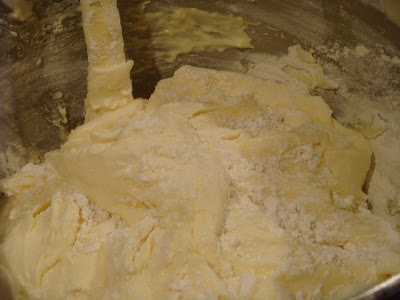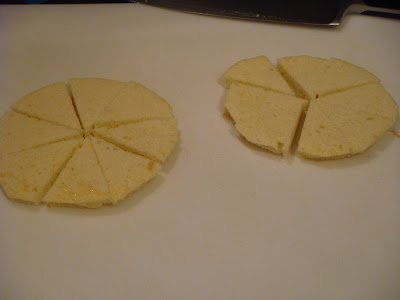
Well, I've left the Daring Cooks and joined the Daring Bakers. I think after seeing those milan cookies and chocolate-covered marshmallow ones from the last challenge, I was feeling a little jealous of the great sweets being created. So here I am, baking away!
The August 2009 Daring Bakers' challenge was hosted by Angela of A Spoonful of Sugar and Lorraine of Not Quite Nigella. They chose the spectacular Dobos Torte based on a recipe from Rick Rodgers' cookbook Kaffeehaus: Exquisite Desserts from the Classic Caffés of Vienna, Budapest, and Prague.
The cake traditionally has six layers. Chocolate buttercream is spread between the layers and used to frost the cake and then the top layer is made into caramel wedges.

I first want to thank Angela and Lorraine for hosting the challenge and presenting the recipe with pictures and very detailed and helpful directions. The notes they added were incredibly useful.
It saddens me to say that this cake, besides the amazingly perfect chocolate frosting (which quite possibly will be my new go-to frosting), was nothing special. It was a ton of work, and I wasn't very happy with the final result. Even though it was challenging to make and it didn't end up being one of my favorite desserts, I still had fun with it.
I decided to make two smaller cakes as opposed to one giant cake. I almost wish I had done even smaller cakes. But I just bought mini springform pans at Crate & Barrel and wanted to try them out, so I made the cake to fit them.
After going through and thoroughly following the recipe, I have some suggestions for making this cake a bit easier to make and a bit tastier the next time. The first thing would be to lose the top layer. The caramel didn't taste all that great. I may have burnt it slightly, but I also saw in the comments from many others that they didn't feel too fondly for it either. I've never made caramel with lemon juice in it, and that may have added to the strange flavor it had.
Making this cake starts with drawing circles on parchment paper that are slightly larger than the size you want your actual cake. You then spread your batter on these circles and bake the cake layers. For what reason couldn't you bake the cake in the pan you want to use and then cut it into layers? And if that's not possible for some reason, why not draw the circles the exact size you want so you don't have to go through the trouble of making the circles smaller afterward? It's time-consuming and leaves too much room for error.
Also, I wasn't impressed with this sponge cake. It was kind of dry -- the opposite of what I'd want in a cake. I much prefer the recipe I used from Mastering the Art of French cooking to make layer cakes for Julia Child's birthday.
Alright, complaints are aired. Let's get to the cake...
Dobos Torte (Recipe that follows is from Daring Bakers with my alterations)
Sponge Cake Layers
Ingredients
6 large eggs, separated, at room temperature
1 1/3 cups confectioner's sugar, divided
1 teaspoon vanilla extract
1 cup plus 2 tablespoons sifted cake flour
pinch of salt
Directions
Preheat oven to 400 degrees.
Cut six pieces of parchment paper to fit your baking sheets. It's easiest if you have two baking sheets that you can rotate into and out of the oven. Using a guide (cookie cutter, cake pan, etc.), trace a circle (or your desired shape) 1 inch larger than you want your final cake (this is what I did, but next time I would just make the circles the size of the cake -- so your choice) on each of the papers, and turn them over (the circle should be visible from the other side, so that the graphite or ink doesn't touch the cake batter).


Beat the egg yolks, 2/3 cup of the confectioner's sugar, and the vanilla in bowl of electric mixer on high speed until the mixture is thick, pale yellow, and forms a thick ribbon when the beaters are lifted a few inches above the batter, about 3 minutes.
In another bowl, using clean beaters, beat the egg whites until soft peaks form. Gradually beat in the remaining 2/3 cup of confectioner's sugar until the whites form stiff, shiny peaks. Using a large rubber spatula, stir about 1/4 of the beaten whites into the egg yolk mixture, then fold in the remainder, leaving a few wisps of white visible.


Combine the flour and salt. Sift half the flour over the eggs, and fold in; repeat with the remaining flour.

Line one of the baking sheets with a circle-marked paper. Using a small offset spatula, spread the batter, filling in the traced circle on one baking sheet (I used a heaping 1/4 cup of batter for my cakes).


Bake on the top rack for 4-5 minutes, until the cake springs back when pressed gently in the center and the edges are lightly browned. While these layers bake, repeat the process on the other baking sheet. When the first pan is done, remove it from the oven, and insert the second pan.

Invert the first cake onto a flat surface and carefully peel off the paper. Slide the cake layer back onto the paper and let stand until cool.

Rinse the baking sheet under cold running water to cool, and dry it before lining with another parchment. Continue with the remaining papers and batter to make a total of six layers (Since I was doing two small cakes, I had 12 layers total).

Completely cool the layers. Trim each cake layer into a neat round of the size you need (or your desired shape). I found it easiest to use a buttered pizza cutter.


Note: The sponge layers can be prepared in advance. I layered mine with plastic wrap, wrapped them tightly, and stored them in the fridge overnight.
Chocolate Buttercream
Ingredients
4 large eggs, at room temperature
1 cup caster sugar (very fine sugar)
4 oz Scharffen-Berger dark chocolate, finely chopped
2 sticks plus 2 tablespoons unsalted butter, at room temperature
Directions
Fill a large saucepan (that your mixer bowl will fit in -- think double boiler) with an inch or so of water and bring it to a boil.
Meanwhile, whisk the eggs with the sugar until pale and thickened, about five minutes.
Fit mixing bowl over the boiling water in the saucepan (water should not touch bowl), and lower the heat to a brisk simmer. Cook the egg mixture, whisking constantly, for 2-3 minutes until you see it starting to thicken a bit.
Whisk in the finely chopped chocolate and cook, stirring, for a further 2-3 minutes.

Scrape the chocolate mixture into a medium bowl and leave to cool to room temperature.

When cool, beat in the soft butter. Make sure to cut it into small pieces to add it to the chocolate. You should end up with a thick, velvety chocolate buttercream (Mine was a bit runny but fine after it was chilled). Chill while you make the caramel topping.

I made my sponge layers and buttercream the night before I did the caramel topping and assembled the cake. This is a good idea if you don't have time to do it all at once.
Caramel Topping (highly recommend doing without this)
Ingredients
1 cup caster sugar
12 tablespoons water
8 teaspoons lemon juice
1 tablespoon neutral oil (e.g., grapeseed, rice bran, sunflower) (I purposely bought a bottle of this for the recipe and then realized it was just used to oil the knife -- skip it and use butter to cut cost if you don't have it on hand.)
Directions
If you refrigerated your cake layers, take them out so they can come to room temperature. Choose the best-looking cake layer for the caramel top.
Line a jellyroll pan with parchment paper, and butter the paper. Place the reserved cake layer on the paper. Cut the cake into equal wedges (like you'd cut a pie), but keep them together. I put my springform pans around the cake wedges, as I thought this would work best for holding the caramel in.


Lightly oil a thin, sharp knife and an offset metal spatula.
Stir the sugar, water, and lemon juice in a small saucepan. Bring to a boil over medium heat, stirring often to dissolve the sugar. Once dissolved into a smooth syrup, turn the heat up to high and boil without stirring, swirling the pan by the handle occasionally and washing down any sugar crystals on the sides of the pan with a wet brush until the syrup has turned into an amber-colored caramel.


Immediately pour all of the hot caramel over the cake layer (or layers if making more than one cake). Using the offset spatula, quickly spread the caramel evenly to the edge of the cake layers.

Let cool until beginning to set, about 30 seconds. Using the tip of the hot oiled knife (keep re-oiling this with a pastry brush between cutting), cut through the scored marks to divide the caramel layer into equal wedges. Cool another minute or so, then use the edge of the knife to completely cut and separate the wedges using one firm slice movement (rather than rocking back and forth which may produce toffee strands). Cool completely.

Finishing touches
12 whole hazelnuts, peeled and toasted
½ cup peeled and finely chopped hazelnuts
Assembling the Dobos
Place a dab of chocolate buttercream on the middle of the bottom of each springform pan or whatever you'll be assembling the cake on (a cardboard round is fine too). Press a layer of cake on top.
Spread the layer with chocolate icing. Repeat with 4 more cake layers. Spread the remaining icing on the sides of the cake.
Optional: press the finely chopped hazelnuts onto the sides of the cake.

Here I highly recommend putting the cake back in the fridge for a while so the buttercream can harden. If you don't, your wedges may slide right off, and you'll be left with a big chocolatey mess. Trust me -- I know!
Once buttercream has hardened, prop a hazelnut under each wedge so that it sits at an angle, arrange the wedges on top of the cake in a spoke pattern.

Refrigerate the cake until the icing is set, and then wrap it if not using it right away. Let slices come to room temperature for the best possible flavor.
Phew! And that's how it's done.

Don't forget to check out the Daring Kitchen and see what the other Daring Bakers came up with!
